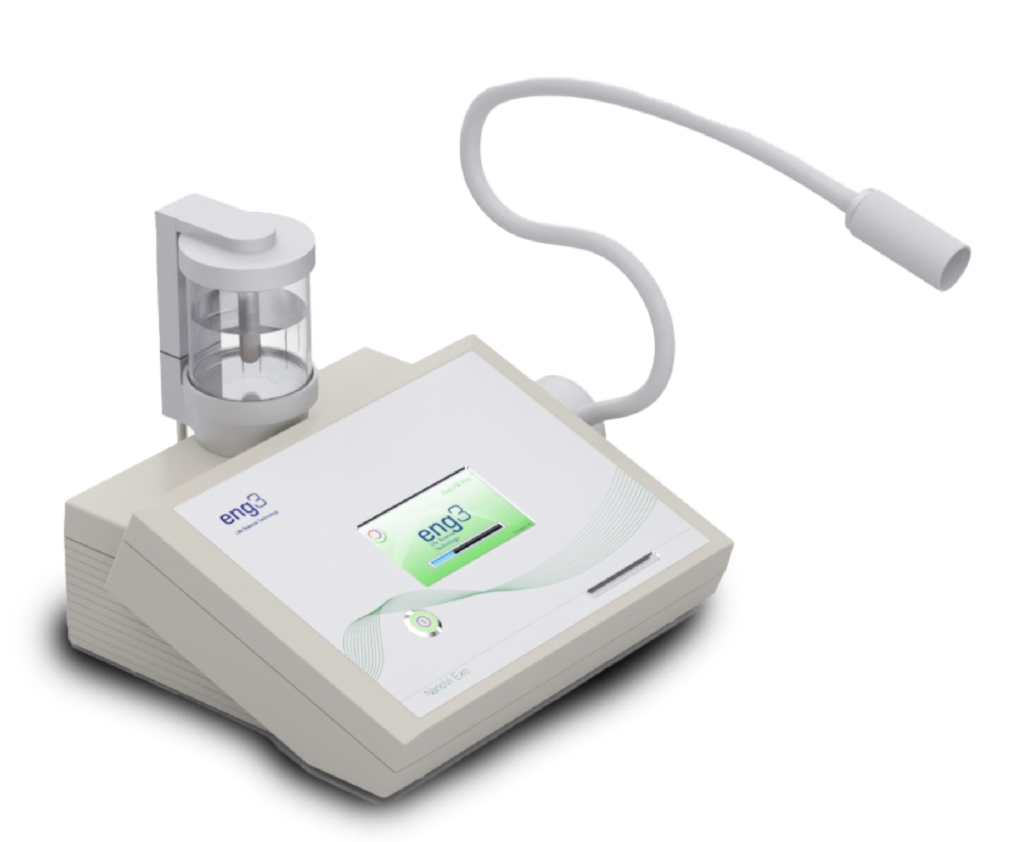Hyperbarics and NanoVi®: An Optimized Combination to
Maximize Results
Why HBOT Centers see better outcomes when they follow HBOT with a NanoVi® session
Hyperbaric oxygen therapy (HBOT) is often combined with NanoVi sessions for enhanced overall outcomes. Considering the mechanisms behind both HBOT and NanoVi technology, this pairing is extremely intuitive and powerful. HBOT is a popular therapy used to help with a wide range of conditions from illnesses to traumatic injuries [1-4]. During therapy, recipients are placed in a chamber to breathe concentrated oxygen under high atmospheric pressures [5,6]. This forces more oxygen into the bloodstream and leads to greatly increased oxygen delivery to tissues throughout the body [4,7]. The result is more oxygen delivery to the parts of your body that need it to function.

Hyperbaric chambers increase the atmospheric pressure to enhance oxygen
delivery to the tissue.
The Biological Impact of HBOT
Oxygen fuels cellular energy production, and a significant amount of extra energy is needed for successful healing [8]. HBOT is known to increase energy-production capabilities both in normal tissues [9] and in tissues recovering from injury [10]. While the energetic bonus of oxygen delivery likely contributes to many benefits of HBOT, its most important effects are believed to come primarily from something else: an increase in the production of reactive oxygen species (ROS) within our bodies [11-13].
The Key Role of ROS
ROS are molecules created as by-products when our cells use oxygen to make energy [14]. This is one reason why flooding the body with oxygen (like in HBOT) leads to an increase in ROS generation [15]. ROS are important chemical signallers in biology; they trigger our bodies to increase wound growth factors, mobilize stem cells, and help reduce harmful chronic inflammation [6,12,16]. All these processes work to increase healing and repair damaged areas of the body.
Beyond enhancing healing, ROS can directly combat infectious agents like bacteria [5,13]. This ability gives HBOT an added boost in helping to treat stubborn infections. Having ROS attack and “oxidize” pathogens is certainly beneficial. Unfortunately, ROS also damage important cellular components such as DNA and proteins [14,17,18]. Fortunately, our cells have mechanisms in place to protect themselves against ROS damage. When, these protective abilities are overwhelmed, it leads to a condition known as oxidative stress [19]. This is why HBOT providers are careful not to overdo HBOT and many centers address oxidative stress by following the hyperbaric dive with a NanoVi session.
Add NanoVi to Increase the Benefits of HBOT
NanoVi technology boosts HBOT’s benefits while supporting the body’s natural defenses. As mentioned before, ROS help trigger healing responses in our bodies. Triggering a healing response, however, is only half the battle. For tissues to repair themselves and for help to be mobilized, our bodies must produce and assemble a vast array of cellular proteins [8]. Proteins are the true workers of our cells—they are molecules essential to controlling chemical reactions, delivering nutrients and signals, and building the structures that define our cells and shape our tissues [20]. Once a protein is made, it must fold from a long strand of amino acids into its appropriate, three-dimensional structure before it can function correctly [21]. It therefore makes sense that for our bodies to build, repair, or simply maintain good health, the ability to create and fold proteins efficiently is key.

The ability of proteins to fold from a chain of amino acids into a 3-dimensional shape is essential for their function and your repair and regeneration.
This is exactly where NanoVi enters the picture to enhance HBOT. Using precise wavelengths of electromagnetic energy transferred to cells throughout the body, NanoVi elicits the formation of a specifically structured water known as exclusion zone (EZ) or ordered water. This ordered water is special, as it has been scientifically observed to increase the folding rate and structural stability of proteins [22]. So, as HBOT-generated ROS signal our cells to produce proteins and begin healing, NanoVi increases the rate and quality of that protein production, resulting in a synergistic effect to greatly speed up and enhance the benefits of HBOT.
How NanoVi Enhances Repair and Performance

Hans Eng speaking about NanoVi at the Hyperbaric Medicine Symposium
By improving protein functions, NanoVi works to maximize the positive outcomes of HBOT. When a protein is hit by ROS, it can become unfolded and lose its function [23].NanoVi increases the speed at which proteins recover their shape and function, meaning that it helps protect cellular proteins and supports overall cellular health [24]. Additionally, NanoVi boosts the production and efficiency of repair enzymes that fix DNA damage. As a result, NanoVi sessions have been shown to support overall cellular integrity [25,26].
NanoVi has been shown to increase the uptake of oxygen and the maximum amount of oxygen an individual can utilize (VO2 max), even in a single session [27]. VO2 max is a standard indicator of performance potential and biological age. Better oxygen utilization is especially beneficial in combination with hyperbarics. HBOT elevates oxygen levels in the blood and tissue and this increase persists post-treatment [28]. Therefore, following a hyperbaric dive with an NanoVi session can increase oxygen utilization while the body has elevated oxygen levels. A NanoVi session within an hour of completing HBOT is an ideal way to increase the benefit from a dive and support the whole system.
HBOT and NanoVi – a Powerful Combination
With this understanding of the mechanisms behind both NanoVi and HBOT, the power of the two in combination becomes clear. HBOT is the most powerful way to create an abundance of oxygen throughout the body. It boosts energy production, addresses pathogens, and signals for important healing processes. NanoVi enhances these processes by improving the efficiency and production of cellular proteins that do the work. NanoVi helps protect cellular components and improves oxygen utilization. Such a complementary dynamic explains why so many HBOT centers and individuals adopt NanoVi as a powerful way to improve their outcomes.
If you’d like to learn more about the NanoVi device, its proven benefits, and the price, sign in below.
If you have any questions about how NanoVi complements oxygen therapies – or anything else, please put a note in the comments box.
References
1. Daly, S. et al. Hyperbaric Oxygen Therapy in the Treatment of Acute Severe Traumatic Brain Injury: A Systematic Review. J. Neurotrauma 35, 623–629 (2018).
2. Heyboer III, M., Sharma, D., Santiago, W. & McCulloch, N. Hyperbaric Oxygen Therapy: Side Effects Defined and Quantified. Adv. wound care 6, 210–224 (2017).
3. Chang, Y.-H. et al. Hyperbaric oxygen therapy ameliorates the blood–retinal barrier breakdown in diabetic retinopathy. Clin. Experiment. Ophthalmol. 34, 584–589 (2006).
4. Bakker, D. J. Hyperbaric oxygen therapy and the diabetic foot. Diabetes. Metab. Res. Rev. 16, S55–S58 (2000).
5. Çimşit, M., Uzun, G. & Yıldız, Ş. Hyperbaric oxygen therapy as an anti-infective agent. Expert Rev. Anti. Infect. Ther. 7, 1015–1026 (2009).
6. Thom, S. R. Hyperbaric oxygen: its mechanisms and efficacy. Plast. Reconstr. Surg. 127 Suppl 1, 131S-141S (2011).
7. McMonnies, C. W. Hyperbaric oxygen therapy and the possibility of ocular complications or contraindications. Clin. Exp. Optom. 98, 122–125 (2015).
8. Demling, R. H. Nutrition, anabolism, and the wound healing process: an overview. Eplasty 9, e9–e9 (2009).
9. Aylin-Burns, N., Krager, K. J., Zhou, D. & Hauer-Jensen, M. Investigating the effects of hyperbaric oxygen on mitochondrial function of endothelial progenitor cells. FASEB J. 31, 711.7-711.7 (2017).
10. Daugherty, W. P., Levasseur, J. E., Sun, D., Rockswold, G. L. & Bullock, M. R. Effects of hyperbaric oxygen therapy on cerebral oxygenation and mitochondrial function following moderate lateral fluid-percussion injury in rats. J. Neurosurg. 101, 499–504 (2004).
11. Benedetti, S. et al. Oxidative stress and antioxidant status in patients undergoing prolonged exposure to hyperbaric oxygen. Clin. Biochem. 37, 312–317 (2004).
12. Bosco, G. et al. Hyperbaric oxygen therapy ameliorates osteonecrosis in patients by modulating inflammation and oxidative stress. J. Enzyme Inhib. Med. Chem. 33, 1501–1505 (2018).
13. Memar, M. Y., Yekani, M., Alizadeh, N. & Baghi, H. B. Hyperbaric oxygen therapy: Antimicrobial mechanisms and clinical application for infections. Biomed. Pharmacother. 109, 440–447 (2019).
14. Schieber, M. & Chandel, N. S. ROS function in redox signaling and oxidative stress. Curr. Biol. 24, R453–R462 (2014).
15. Zhou, Q., Huang, G., Yu, X. & Xu, W. A Novel Approach to Estimate ROS Origination by Hyperbaric Oxygen Exposure, Targeted Probes and Specific Inhibitors. Cell. Physiol. Biochem. 47, 1800–1808 (2018).
16. Grimberg-Peters, D., Büren, C., Windolf, J., Wahlers, T. & Paunel-Görgülü, A. Hyperbaric Oxygen Reduces Production of Reactive Oxygen Species in Neutrophils from Polytraumatized Patients Yielding in the Inhibition of p38 MAP Kinase and Downstream Pathways. PLoS One 11, e0161343–e0161343 (2016).
17. Lobo, V., Patil, A., Phatak, A. & Chandra, N. Free radicals, antioxidants and functional foods: Impact on human health. Pharmacogn. Rev. 4, 118–126 (2010).
18. Phaniendra, A., Jestadi, D. B. & Periyasamy, L. Free radicals: properties, sources, targets, and their implication in various diseases. Indian J. Clin. Biochem. 30, 11–26 (2015).
19. Pizzino, G. et al. Oxidative Stress: Harms and Benefits for Human Health. Oxid. Med. Cell. Longev. 2017, 8416763 (2017).
20. B, A., A, J. & J, L. Protein Function. in Molecular Biology of the Cell (Garland Science, 2002).
21. Dobson, C. M. Protein folding and misfolding. Nature 426, 884–890 (2003).
22. Zuo, G., Hu, J. & Fang, H. Effect of the ordered water on protein folding: An off-lattice Go-like model study. Phys. Rev. E 79, 31925 (2009).
23. Reichmann, D., Voth, W. & Jakob, U. Maintaining a Healthy Proteome during Oxidative Stress. Mol. Cell 69, 203–213 (2018).
24. Yablonskaya, O. I., Trofimov, A. V., Voeikov, V. L., Novikov, K. N. & Buravleva, E. V. Evidence of Protective and Regenerating Properties of NanoVi water vapor. in Annual Water Conference 1 (2018).
25. Sharma, V. et al. Oxidative stress at low levels can induce clustered DNA lesions leading to NHEJ mediated mutations. Oncotarget 7, 25377–25390 (2016).
26. Dörr, W. & Bozsaky, E. Improved Regeneration of DNA Double Strand Breaks with NanoVi(TM) Bio-identical Signaling Technology. (2014).
27. Pnoe Assessment of the impact of novel therapy on key cardiometabolic variables. White Paper (2023)
28. Gottfried, I., Schottlender, N., Ashery, U. Hyperbaric Oxygen Treatment—From Mechanisms to Cognitive Improvement. Biomolecules, 11.10, 1520 (2021).



